Temples of Angkor, Siem Reap – Cambodia
Cambodia, a country of deeply rooted culture, emerald rice fields, ancient temples, and a horrific past. Mentioning the name “Cambodia” to the younger generation inspires thoughts of of backpacking and South East Asian adventure. Ask someone whose memory stretches back a little farther, however, and you will be shocked to learn of the unspeakable acts of genocide that occurred here very recently.
Cambodia has emerged from the ashes of disparity and bloomed into one of South East Asia’s most interesting and addictive destinations. It shows great promise in continuing this path. It’s got new paved roads, five star hotels and everything else a traveler could want. The real questions is: will Cambodia be able to retain its authentic feeling with all of this new tourist infrastructure?
I have traveled here countless times. Every time I step through the gates of Angkor Wat, I can tell you that even with all the swarms of tourists, hotels, hawkers, this place is special. Angkor Wat is the symbol of Cambodia’s past. Angkor Wat is a prime example of Cambodia’s will to hang on to its culture, while giving its people a sense of belonging and pride. In short, Angkor Wat is absolutely stunning.
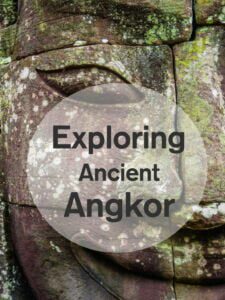
Siem Reap, the Gateway to Angkor Wat
In recent years, Siem Reap has changed, more so than any other town in the whole of Cambodia. The roads, for the most part, are all paved now. Hotels have sprung up everywhere like wildfire. Siem Reap has an almost Thai city feeling to it these days. Head into the touristy markets and you will see souvenirs from Thailand, Fish Massage Spas and Thai cuisine. Venture off into the real Siem Reap and you will see traditional Cambodian rural culture right on the outskirts of the city.
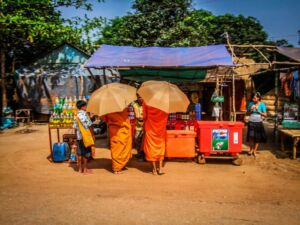
Siem Reap is still a great city to base yourself out of to get to Angkor Wat. Its convenient, containing a lot of options for accommodation and food. It’s also the main place to arrange for whatever form of transport you choose into Angkor.
Getting to Siem Reap these days could not be easier. There is an airport, tons of bus connections from Phnom Penh and even international bus connections from Bangkok or Ho Chi Minh City. Now that most of the roads in Cambodia are paved, you can make the journey here in one day from Vietnam, or Thailand, albeit, one long day.
As for accommodation, Siem Reap will tailor to whatever budget you arrive here with. Hostels, guesthouses, hotels, boutique hotels, doesn’t matter, Siem Reap offers it. I prefer to stay at the “Shadow of Angkor Guesthouse.” Why do I like to stay here out of all of Siem Reap’s options, you ask? I am a bit of a traditionalist. I enjoy the past, especially when I travel. This guest house happens to be an old French Era building. Staying here is like stepping into Cambodia’s amazing colonial past. Who cares about the comforts and amenities of the posh new guesthouses? I like things old school.
Visiting the Temples of Angkor
The ancient Khmer built Angkor the represent a symbolic version of Mt Meru on Earth (like a Hindu Heaven). They constructed over a thousand temples here! Angkor Wat actually refers to only one of these spectacular temples. So how do you go about seeing them?
The best thing you can do, in order to get the most out of seeing the temples here with your limited time, is to just pick a few of the major temples. Ask any rickshaw driver and they will probably give you a good idea which ones these are. Below, I am including a few of my favourite temples here.
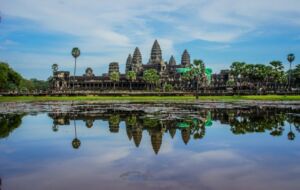
There are several ways to visit the temples. Obviously, you can just walk or rent a bicycle, but you should not underestimate how spread out the temples of Angkor are. Another option is to rent a car – this is not my preferred option as I feel like you do not experience much other than being cooped up inside an AC car. The other, more enjoyable option, is to get a Rickshaw.
Siem Reap’s thousands of Rickshaw drivers are well informed on the history, sights, and master haggling skills. So, come prepared to bargain and make sure you get to know your driver so that no hidden surprises pop up later. For the most part, every rickshaw driver I have dealt with was an absolute pleasure.
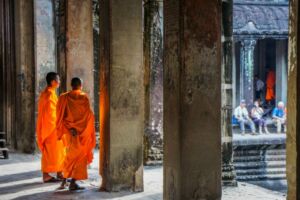
Rickshaw drivers will charge anywhere from $15 – 30 USD per day, depending on the locations within Angkor. Expect to pay almost double that if you want to visit Kbal Spean, as its very far north of Angkor.
Admission for Angkor Wat: One Day Pass –$20 US, Three Day – $40 US, One Week – $60 US.
Temple of Angkor Wat
The namesake and most famous temple of the area is Angkor Wat. This mother-of-all-temples is the largest religious temple complex in the world. Seeing it for the first time is nothing less than breathtaking.
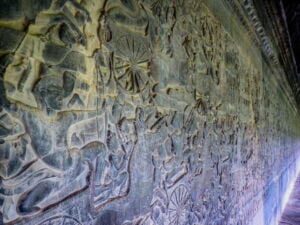
The temple is surrounded by a large moat over which there are two bridges you can choose between to cross. The main entrance is the most dramatic. From the opposite side of the moat, you get your first glimpse of the honey comb domes atop Angkor. In the early morning light, Angkor reflects from the still moat water, making this scene almost unbelievable.
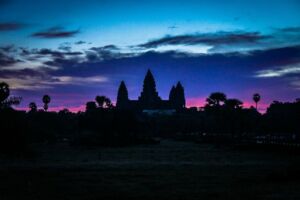
Most people visiting Angkor Wat come for sunrise. This can be both a very pleasant and annoying experience. Seeing the sun rise over Angkor is stunning, but like all good things in the travel world, it has inevitably been sought out by the masses. These days, you will be joined by hundreds of other tourists who cannot seem to control the flash on their cameras and will yell very profusely at you if you dare to step in from of their Angkor Wat sunrise photo-op.
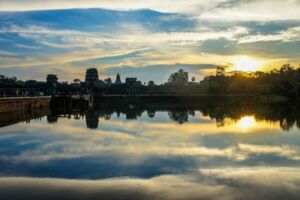
Inside, the temple the walls are immaculately carved, depicting many Hindu stories of the past. It’s best to have a guide, or guide book, if you are interested in learning about these legends. The centre complex has several rooms containing figures of Hindu deities being swathed in strong perfume incense. Each one these provide an up-close look at the intricately carved, honeycombed domes of Angkor.
If you want to avoid crowds here, try visiting during mid-day, when all the tour groups are having lunch. I did so, and had almost the entire temple to myself, a hauntingly creepy experience.
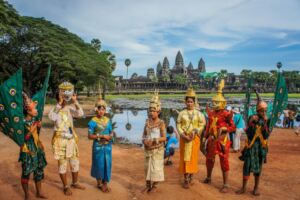
Angkor Thom – The many Faces of Bayon
Angkor Wat was the spiritual centre for the ancient Khmer, but Angkor Thom was the ruling divine power. Its construction was ordered by King Jayavarman VII and served as his residence, but its main purpose was to demonstrate his absolute power over the Khmer. Angkor Thom is complete with royal bathing pools, elephant stables, royal enclosures and Bayon, the structure famous for its many faces of Avalokiteshvara.
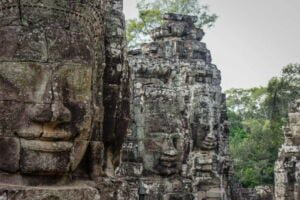
Bayon is easily recognized by the countless smirking faces surrounding the domes of each part of the temple structure. Walking around Bayon is spectacular during different times of the day. Each time of day casts a new light upon the different angles and corners of the faces, making for a photographers dream. The faces of Bayon resemble the king Jayavarman VII himself, making historians agree that Bayon is just one giant temple devoted to the king’s arrogant and loving ego.
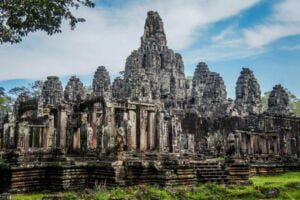
You will need at least half a day to fully appreciate the grand scale and history of Angkor Thom. You can walk from many of the temples within Angkor Thom to another, exploring the area on foot rather than by rickshaw.
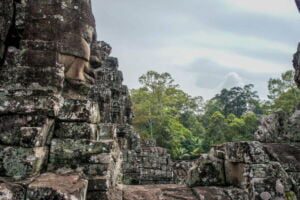
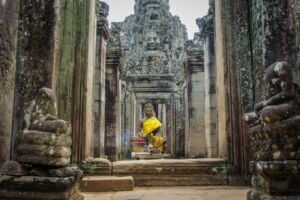
Baphuon and Bayon are the most impressive structures within the Angkor Thom enclosure. Baphuon is quite different from Bayon Lacking the smirking faces of the king, this temple is being reconstructed bit by bit since its destruction during the Khmer Rouge.
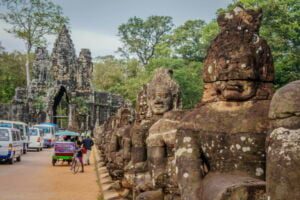
Ta Prohm (Unfortunately Known as the “Tomb Raider” Temple)
Yes, Angelina Jolie filmed scenes from Lara Croft Tomb Raider here. But the real exciting thing about this temple is the feeling of being a real adventurer that one experiences whilst exploring this structure. Giant tree roots slowly are reclaiming the temple as it is slowly swallowed by the encroaching jungle.
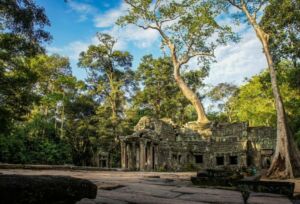
Built in 1186, this Buddhist temple will, without a doubt, be the one temple, other than Angkor, that you will never forget. Wandering the temple corridors that are being ripped apart from the jungle are reminiscent of what explorers would have first come to when they discovered Angkor for the first time.
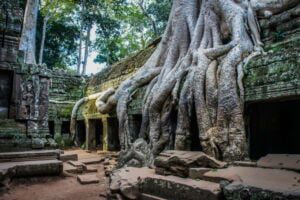
You can visit at any time a day, but if you come later in the evening there tends to be less tourists. The sounds of the jungle arise as the sun sets, and the setting here becomes incredibly calming. Much of the temple is off limits, due to the possibility of parts of the temple caving in.
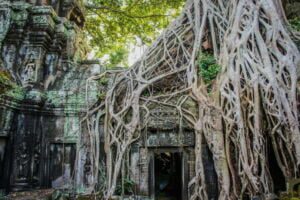
Roluos Group
13 km east of Siem Reap lay the ruined temples of Roluos. The temples of Preah Ko, Bakong, and Lolei are amongst some of the oldest structures in the area. Predating most of what you see in Angkor, Roluos temples tend to be made from simpler materials such as brick and wood.
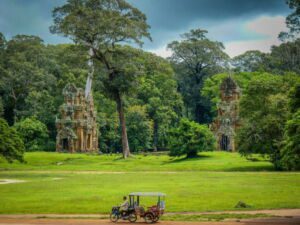
You will need an extra half day to visit these temples. It is worth coming out here to see the more classical style of the Khmer period. Rickshaw drivers will most likely ask for more money to visit here as it is further away.
Banteay Srei – Where the Ancient Cambodian Hipsters’ Hang Out
16km north of the Angkor complex is the small temple of Banteay Srei. Now this may be a small temple, but what it lacks in size it makes up for in beauty. This Hindu temple, dedicated to Shiva, has some of the highest quality of stone carvings that can be found on Earth!
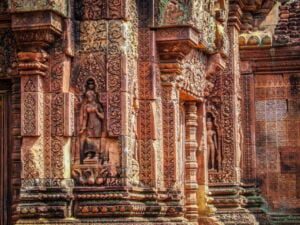
Constructed in 967 AD, this is one of Angkor’s most special temples, due to the fact that it really is one of the only temples here that displays incredibly detailed artisanal craftsmanship rather than macroscopic architectural wonder. Not to say that the architecture is not impressive; it is! A visit to Banteay Srei is well worth the trip.
In an afternoon, you can easily combine Banteay Srei with the carved rivers of Kbal Spean. Your rickshaw driver will probably ask you for about double what you normally pay for this. If you just want to visit Banteay Srei then your rickshaw driver should not want any more than another $5 US or so.
Kbal Spean – Even the Rivers are Carved!!
Welcome to one of Angkor’s hidden, secret wonders. I say hidden because many tourists do not make it all the way up here. To see the river there is also a 2km, 15-30 min, hike, uphill along a densely forested, gnarly, root covered path. Make sure that you bring plenty of water, as there are very little tourist facilities apart from a snack stall at the beginning of the trail.
Land Mine Alert – Extreme precautions should be taken while visiting his part of Angkor as there are still plenty of landmines planted throughout the jungle. This area in particular was heavily mined. Absolutely for sure do not venture off of the marked trail. Travel Cambodia’s rural country side and you will see many farmers and children missing legs from landmine explosions. Venture off of the trail and you too could be like them.
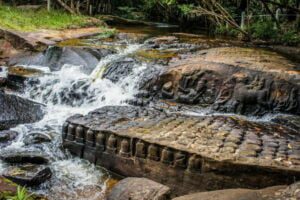
Kbal Spean, commonly known as “The River of a Thousand Lingas,” is a must stop for all those who want to get “off the beaten path” at Angkor. It’s called “The River of a Thousand Lingas” for a reason: there are indeed thousands of Shiva Lingas (round carved rocks representing the male appendage) carved into the river bed here. Along with all the Lingas, there are also carvings of Vishnu, Shiva, cows, frogs, and many other animals.
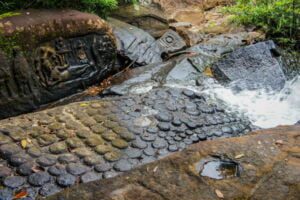
It’s best to visit here between July and December, when the water levels are lower. Outside these months, the water can be high enough that it covers all of the carvings. As I said with Banteay Srei, you can combine visiting these two sites together. To visit both, your driver will usually ask for double the regular cost for the day. This is because Kbal Spean is 31 km north of the Angkor complex.
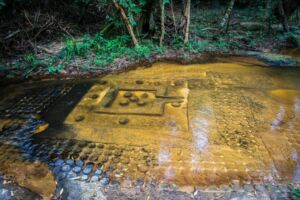
The Floating Villages of Chong Kneas
Once a peaceful village floating atop of the Tonle Sap lake, Chong Kneas is now bustling from the influx of tourists and travelers coming here seeking a bit of respite from their temple excursions. The village is still incredibly traditional, and provides great insight into Cambodia’s rural culture.
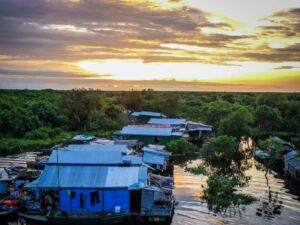
Coming here on your own is not too difficult, but can tend to be pricey if you are not with a group. This is because you will have to rent your own boat and foot the price alone. These days, most people join a tour here that will show you how the people have lived for centuries and usually includes lunch on the lake.
Even though Chong Kneas has become touristy, it’s still well worth the visit, especially if you have never visited one of South East Asia’s floating villages before.
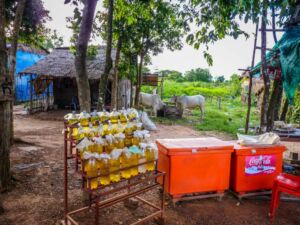
Cambodia’s Dark Past – Wat Thmei Pagoda
Many people come to Cambodia not even knowing about its recent horrific past. This Pagoda, just on the outskirts of Siem Reap, provides a dark look into the atrocities endured by the people of Cambodia. If you are not going to visit the killing fields in Phnom Penh, then this Pagoda can give you some insight of how much suffering Cambodia has gone through.
Inside the Pagoda, there is a pile of human skulls and bones, all victims of the Khmer Rouge. Around the Pagoda you will meet plenty of Buddhist monks who come here to practice their English with travelers. This temple Pagoda provides a great break in between Angkor’s ancient temples, and something new for Siem Reap travelers.
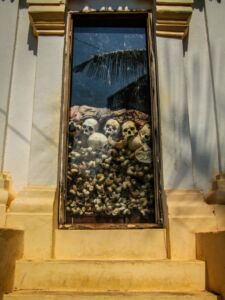
Useful Information
Location: Siem Reap, Angkor Wat, Cambodia
Daily costs: $15-30 US for rickshaw, plus entrance tickets.
Flights: Momondo
Recommended Guide Book: Lonely Planet Cambodia, Khmer Phrase Book
Recommended Tour companies: G Adventures Cambodia
Accommodation: Shadow of Angkor Guest House www.shadowofangkor.com
Visa for Cambodia: Obtained On Arrival at most land/air borders.
Tips: Make sure you ask around for a rickshaw driver, do not take the first guy that approaches you as they are usually just trying to rip you off. Siem Reap has plenty of great Rickshaw drivers who will give you a decent price, but more importantly a memorable experience that you will never forget!
Gear: Check out my “What’s in my Bag” post for ideas of what cameras and gear I used here.
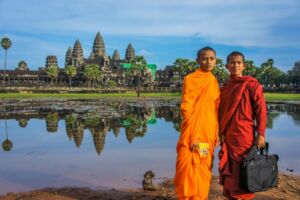
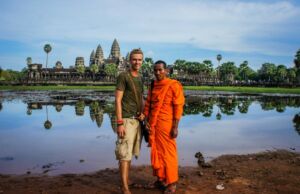


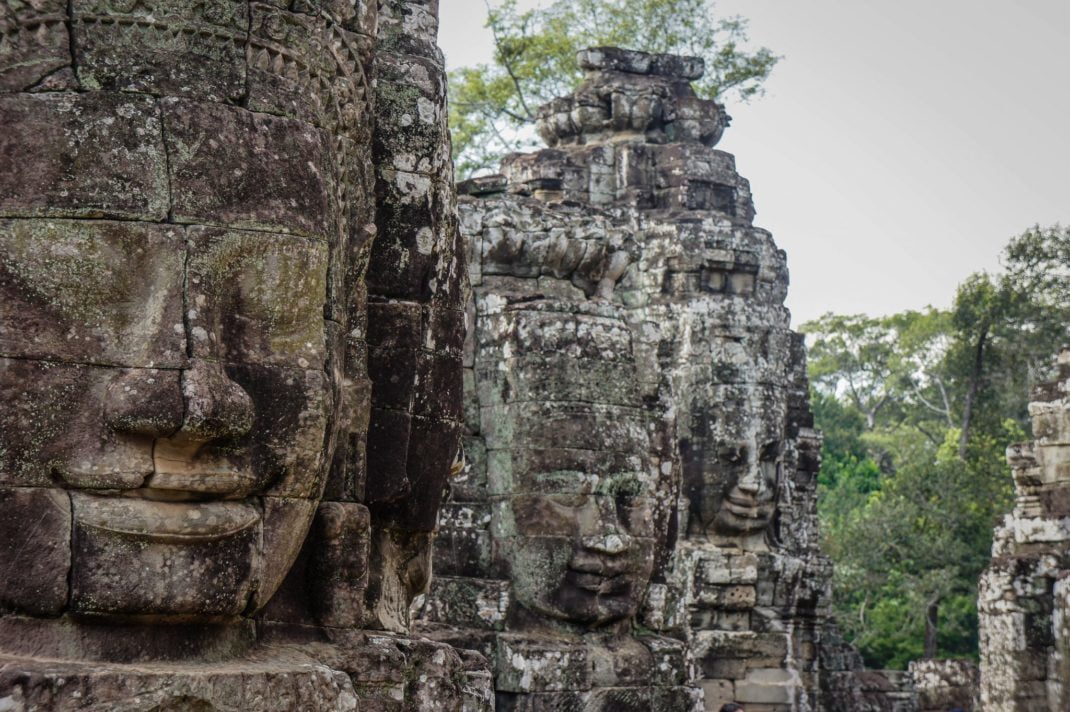
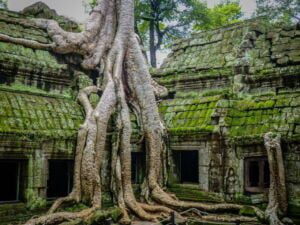
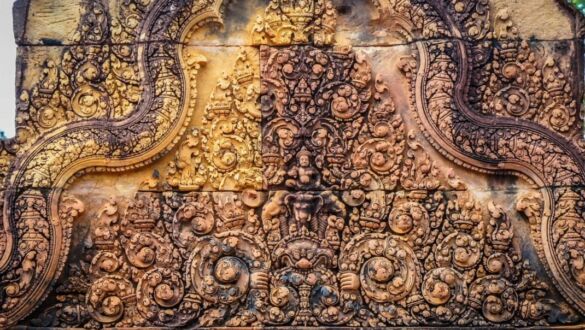
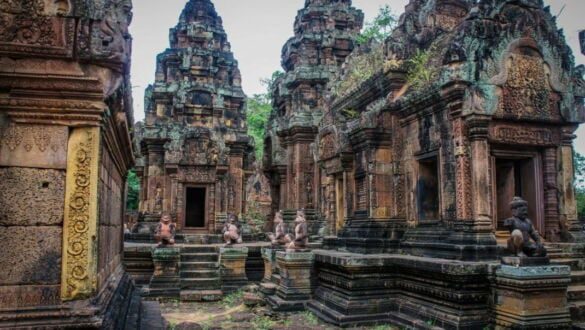
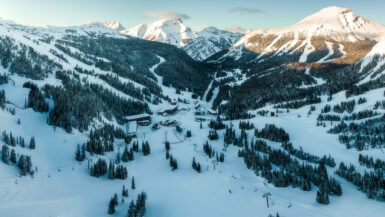
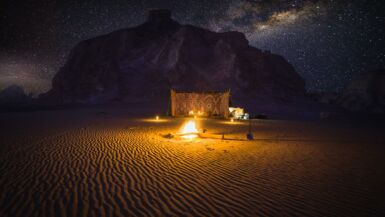
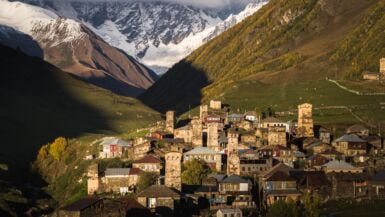
Angkor Wat very great.
I’m really happy to say it was an interesting post to read. I learned new information from your article, you are doing a great job. – shirdi flight package from chennai, mumbai flight package from chennai
I think this is one of the most significant information for me. And i’m glad reading your article. Thank for sharing! – sameday shirdi flight package, shirdi flight package sameday